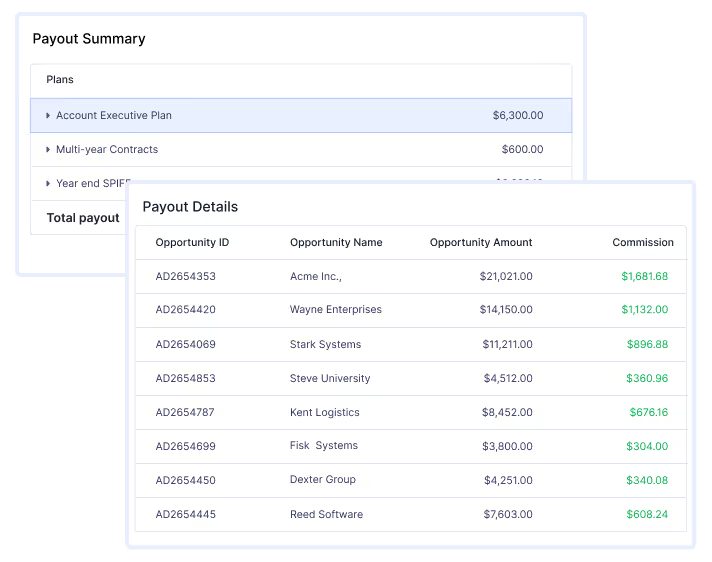Sales commission calculation is essential for ensuring accurate, fair payouts and motivating sales teams to perform at their best.
- Prevent payout errors by understanding your commission structure and calculation methods.
- Choose the right commission model—revenue, margin, tiered, or base plus commission—to align with business goals.
- Leverage automation tools for transparent, efficient commission tracking and reporting.
- Build trust and drive results with clear, well-designed compensation plans.
Reps, the last thing you’d want after spending the entire quarter closing deals is an incorrect commission payout. However, that’s what happens! To avoid inaccurate compensation, it is important to have a good understanding of your sales commission structure and how to calculate sales commissions.
Before you calculate sales commissions, having an effective sales compensation plan in place ensures that the sales reps are rewarded fairly for promoting your product or service and bringing home more customers.
In this blog, we’ll be covering:
- 8 typical sales commission structures
- 5-step approach to designing your commission structure
- How to calculate sales commissions
8 Typical Sales Commission Structures
It is crucial to understand what sales commission structures apply to your sales team. It gives you clarity on what you are setting out to achieve.
Revenue Commission Structure
Perhaps the most commonly used structure is the simple revenue commission model. The sales commission calculation is done with a flat percentage of a single sale’s revenue.
Commission = Commission Percentage x Sales Amount
For example, imagine you close a deal for $100,000 with a commission rate of 5%, you will receive $5,000 in commission. This structure works great for smaller sales teams where the focus is on one single product or service that has a fixed price.
Gross Margin Commission Structure
Gross margin commission is also quite simple to implement. Similar to the revenue commission structure, it takes into account the profit of each transaction, the price of the sale, and the costs associated with it. The only difference is it calculates commissions based on the gross revenue generated rather than the total sales amount.
Commission = Commission Percentage x Gross Revenue Generated
If your product costs $100,000, and you incur a cost of $10,000 for that sale. The profit would be $90,000. If the commission rate is five percent, you receive $4,500 in commission.
It is ideal when scaling teams and focusing on keeping reps motivated.
Draw Against Commission Structure
Draws must be included in a rep’s commission plan, as it serves as a guarantee of cash flow on days when the rep is not able to meet quotas or close deals. It is a predetermined amount which imitates the functions of a loan or an advance which the rep needs to or need not pay back, based on the compensation plan. Draws are common for when the rep is a new joinee or during times of uncertainty.
Tiered Commission Structure
Tiered commission works great to motivate reps to surpass set sales quotas. If a rep has attained their sales quota, they might not be driven to close more deals as they won’t get paid anymore. So, to make sure they continue to close deals, you could add a higher commission rate after the 100% threshold.

Taking the same example of earning 5% on each product costing $100,000 in total sales, after the rep exceeds this quota, you can increase the commission rate to 8% percent and so on. This encourages reps to over-perform as the amount they expect to earn increases, thanks to the higher percentage.
Tiered commission plans play an important role in scaling the sales team and business. Since they are designed to promote over-performance, they can be extremely effective compensation models for driving revenue in larger, more established sales teams.
Multiplier Commission Structure
This type helps companies create custom-made commission plans. It starts with a revenue commission model and is then multiplied by a percentage based on quota achievement. The sales commission formula allows the rep to start with a base commission rate and have a multiplying factor as and when they surpass their percentage to quota thresholds.
This commission calculator is useful when multiple performance measures are included in the incentive plan. It can be quite hard to implement unless you have clarity on the parameters.
Base Pay Rate Only
This structure is very uncommon in sales organizations wherein a flat hourly rate or salary is offered without any incentives for selling more. The major drawback here is that the highest and the lowest performer will be paid the same. This type is employed in companies that function solely on inbound leads.
Base + Commission
It is as simple as it sounds. In this structure, both the company and the sales reps share responsibility for the deals. The company pays an hourly rate or a salary irrespective of the reps' performance and the rep closes deals to gain more through commissions on top of their base pay.
Graduated Commission
Graduated commission as the name suggests compensates salespeople based on the increase in sales. The commission rate increases incrementally with the sales volume. It focuses on performance and can be immensely lucrative for over-achiever reps.

Understanding Your Sales Commission Plan
Although reps depend heavily on their incentive pay, they are quite oblivious to their compensation structure. Here are the three things reps need to know about their incentives.
- Find out what your commission is based on.
- Determine the commission rate that your company pays.
- Learn about any other nuances in your commission plan.
Factors that Influence Commission Calculation
The following factors typically apply to the calculation:
- Commission rate
- Commission basis
- Overrides
- Splits
- Commission period
- Commission tier
5-Step Approach To Designing Your Commission Structure
Designing your commission structure is not quite a linear process. And, it certainly is not a one-size-fits-all solution. Here are five steps on how you can go about developing your plan.
Step 1: Know and understand profit and sales goals plus your sales expense budget
Step 2: Consider and assess all job factors of each sales position
Step 3: Determine individual sales goals and fair compensation for all sales positions.
Step 4: Decide whether to blend salary, commission and bonuses or use just one.
Step 5: Consider offering other perks and benefits, if funds permit.
How to Calculate Sales Commissions?
Now that you have the compensation structure in place, it is time to focus on the process that will act as a determinant for the commission calculator.
- Determine the commission period. How often will the reps be compensated? Will it be monthly? Quarterly?
- Calculate the total commission base you made during the period. The amount you’ve brought to the table by closing deals and retaining customers.
- Multiply your commission rate by your commission base. Based on your commission structure, you would have a commission rate already decided for you.
- Take variable commission rates into account, if any.
- Allow for tiered commission rates.
- Calculate override if it applies.
- Deduct returns, if necessary.
- Split the commission, if necessary.
- Calculate the manager's portion, if it applies.
If you are confused about how to go about this, you can calculate your commissions on an automation platform or sales compensation calculator. Having full visibility of your commissions is a great way to boost your earnings.





.avif)
.avif)
.avif)

%20Quota-to-OTE%20Ratio_%402x-p-1080.avif)

.avif)

